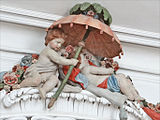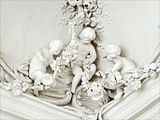Johann Michael Graff
Johann Michael Graff (Latvian: Johans Mihaels Grafs; sometimes also Johann Michael Graaf, Johann Michael Graaff, Johann Michael Graf or Johann Michael Kraff,[1] fl. c. 1765-68),[2] was a German Rococo sculptor and plasterer.[1] Among his most celebrated decorations are those at Schönhausen Palace, Germany, and Rundāle Palace, Latvia.
Graff came from a family of stucco decorators from Bavaria who were members of the so-called Wessobrunner School. He seems to have moved to Brandenburg at some point, where he was influenced by the decorative style predominant in and around Berlin.[3] He very probably made decorations for Schönhausen Palace before being hired by the Duke of Courland, Peter von Biron, to decorate his residences in present-day Latvia.[4] He is known to have decorated Jelgava Palace[3] (decorations destroyed during World War II) and Rundāle Palace[5] for the Duke. In present-day Estonia, he also made lavish stucco decorations for Põltsamaa Castle (destroyed during World War II), and possibly at Kabala Manor.[6]
Gallery[edit]
-
Stucco decoration by Johann Michael Graff in Rundāle Palace, Latvia
-
Stucco decoration by Johann Michael Graff in Rundāle Palace, Latvia
-
Stucco decoration by Johann Michael Graff in Rundāle Palace, Latvia
-
Stucco decoration by Johann Michael Graff in Schönhausen Palace, Germany
-
Stucco decoration by Johann Michael Graff in Põltsamaa Castle, Estonia (destroyed)
References[edit]
- ^ a b "Johann Michael Graff". Artfact. Archived from the original on 10 November 2013. Retrieved 10 November 2013.
- ^ "Rundāle Palace and Museum". Latvia - Best enjoyed slowly. Retrieved 10 November 2013.
- ^ a b "Jelgava Palace Today and Earlier" (PDF). eu-projekt.net. Retrieved 10 November 2013.
- ^ Lancmanis, Imants. "Die Arbeiten des Stuckateurs Johann Michael Graff in Põltsamaa - ein Rokoko-Kunstwerk Zwischen Berlin und Kurland". Baltic Journal of Art History (2009 (Autumn)). Chair of Art History of the Institute of History and Archaeology of the University of Tartu: 105–131. Retrieved 10 November 2013.
- ^ "The Duke's state apartments". Rundale Palace. Archived from the original on 10 November 2013. Retrieved 10 November 2013.
- ^ Sakk, Ivar (2004). Estonian Manors - A Travelogue. Tallinn: Sakk & Sakk OÜ. p. 29. ISBN 9949-10-117-4.





